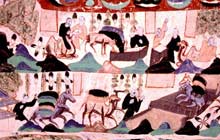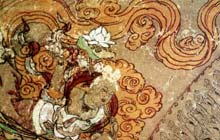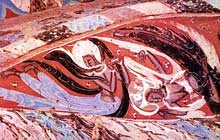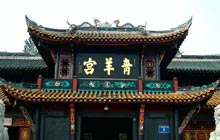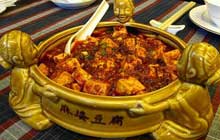These are the bare facts: the Mogao cave complex is comprised of 492 caves, containing 450,000 square feet of murals dating from the fourth to the fourteenth centuries – a period which corresponds to an immense growth in international commerce along the nearby Silk Road. The caves were abandoned in the fourteenth century and lay untouched until the beginning of the twentieth century.
These facts presume ten centuries of consecutive public works programs of astonishing financial proportions and startling logistical complications. » Read more »
» Read more »By Guy Rubin
Centuries ago, in a cliff-face in the midst of China's vast Taklamakan desert, artists hollowed, sculpted and painted 492 caves, creating over 450,000 square feet of spectacular murals, or more than thirty times the mural area of the Sistine Chapel. But whereas the Sistine Chapel was painted over a few years, the works at the Mogao Caves began in the fourth century and were completed over the next millennium. » Read more »
» Read more »Day One
At the end of our flight, the oasis town of Dunhuang appears unexpectedly in the midst of a seemingly infinite sandy desert. After landing here in the late afternoon, we will check into the Sun Villa Hotel. Tonight, dinner will be served al fresco in the hotel's spacious gardens (weather permitting). (Silk Road Hotel – Deluxe Suite) (D)
Day Two
The day starts at one of the world's most impressive cultural heritage sites, » Read more »
» Read more »Qingyang Temple , which literally means Temple of the Dark Ram, is the most exquisite and active Daoist temple in Chengdu . The name is associated with many myths, such as Laozi (the mythical founder of Daoism) claiming that he would be reborn in a market where dark rams were sold, to a meeting of Daoist luminaries at which some dark rams were seen. Whatever the truth of the name, it was acquired in the ninth century after some remarkable phenomenon led to the unearthing of a box which contained a seal on which ancient characters with a Daoist message were carved. » Read more »
» Read more »Day One
Today you will fly to Chengdu, the capital of modern Sichuan province. A historic capital serving as the traditional gateway to the Tibetan plateau, Chengdu has in recent years become a vibrant and sophisticated metropolis. Prepare yourself for mouth-watering Sichuan food, wonderful cultural sites and of course one of the rarest bears on our planet. (Shangri-la Hotel – Executive Riverview Room) (B, L, D)
» Read more »
» Read more »